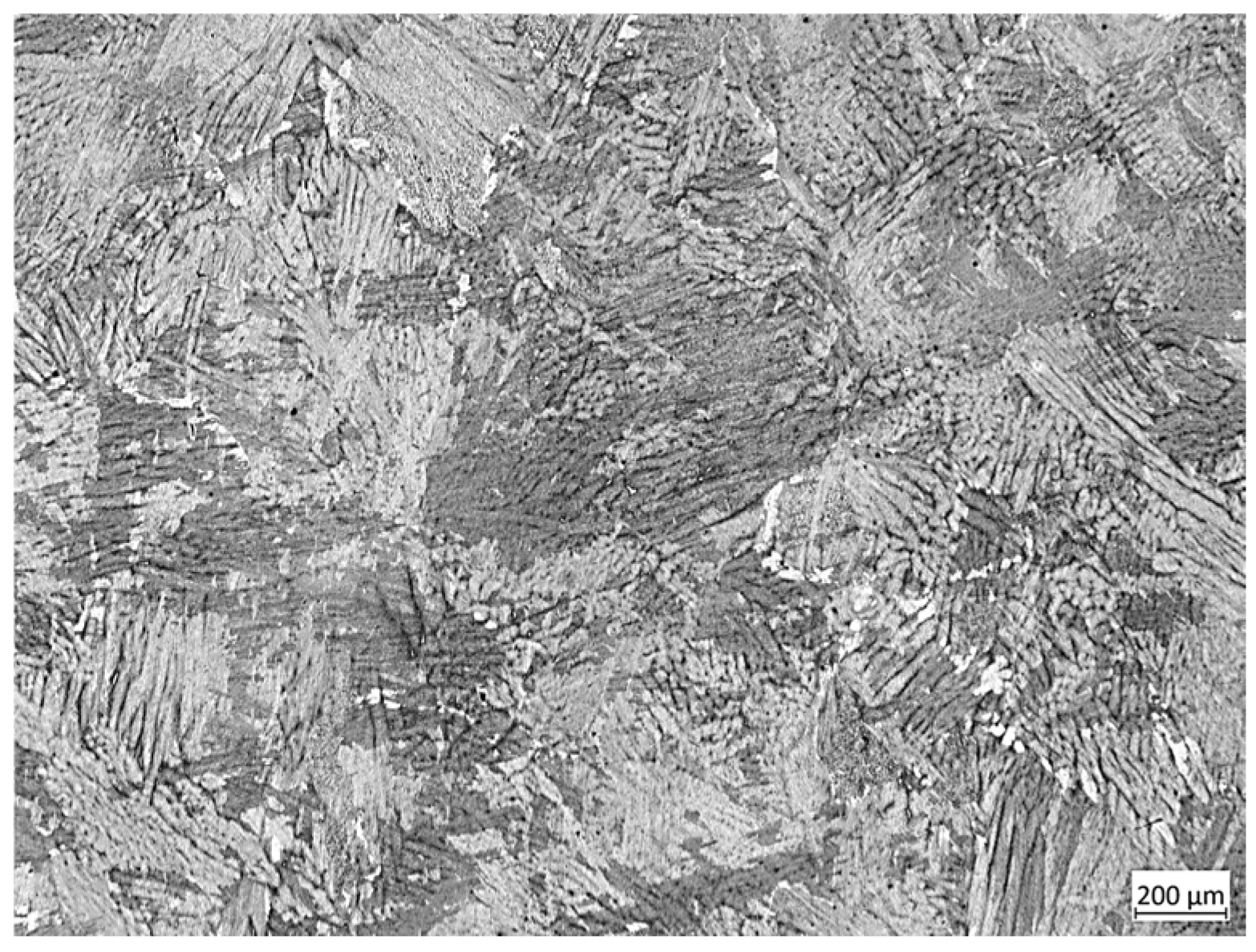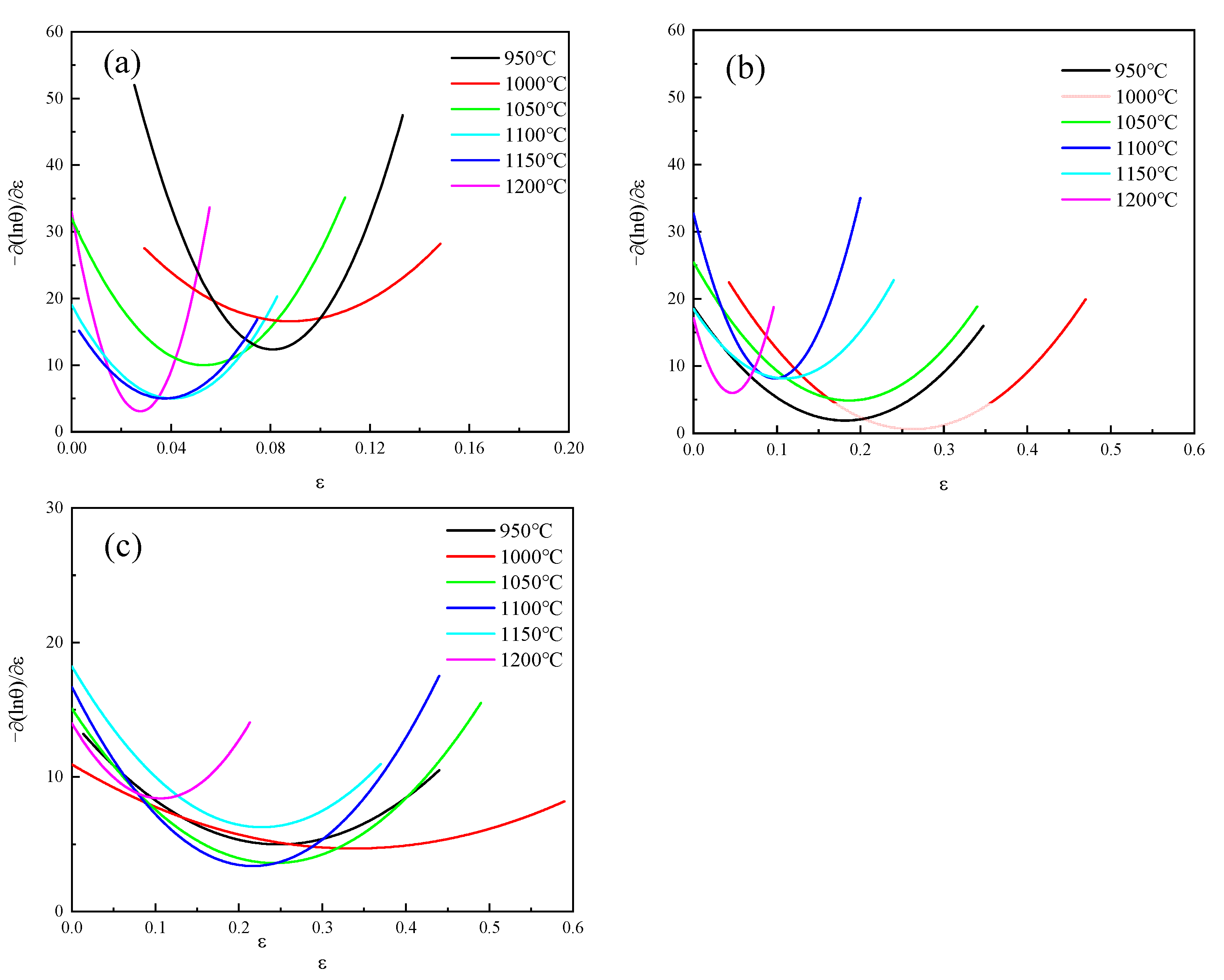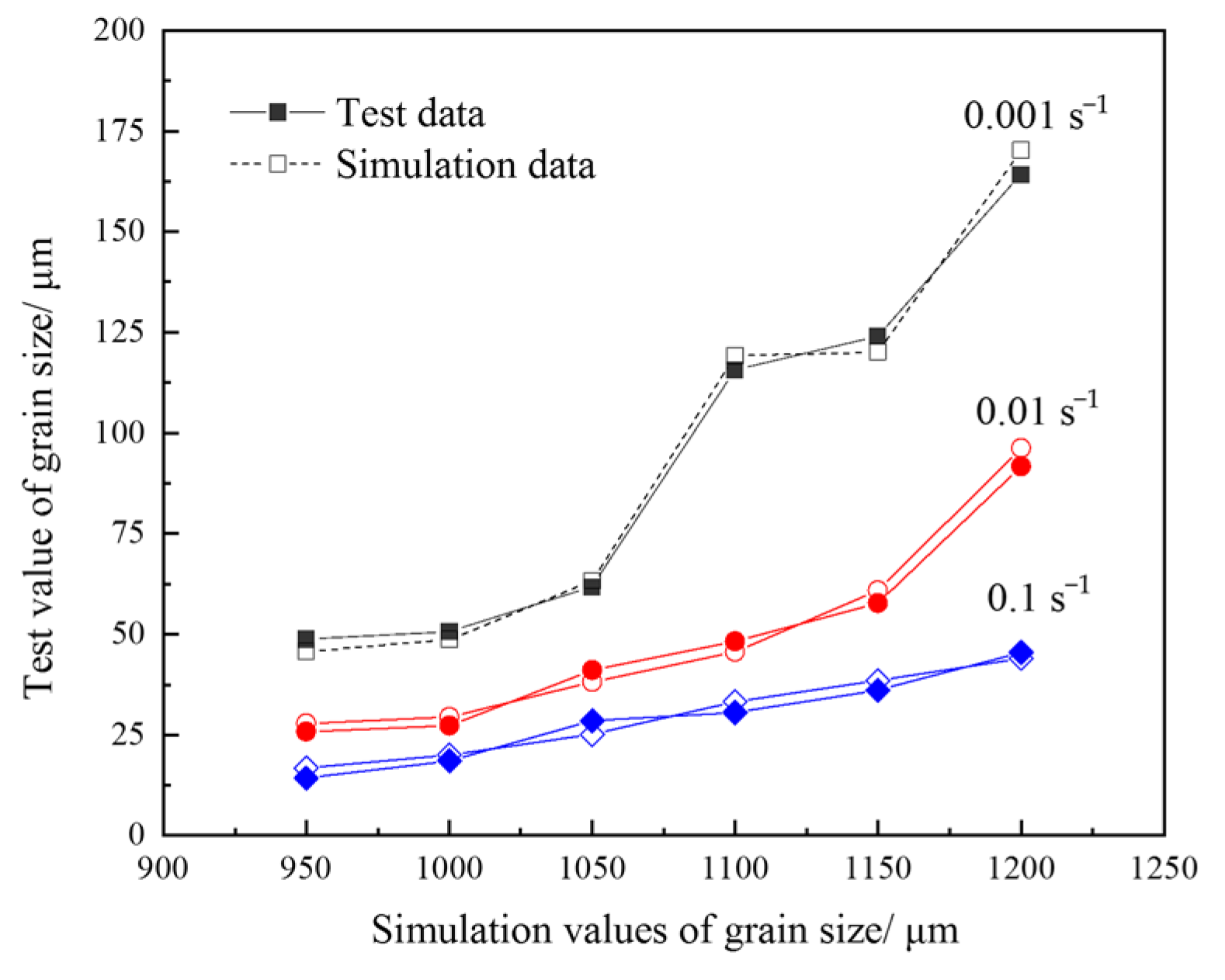1. Introduction
The alloy 04Cr13Ni5Mo is a low-carbon martensitic stainless steel with chromium (Cr), nickel (Ni), and molybdenum (Mo) as its primary alloying elements. It is also known as ASTM A182 F6NM, which has a similar composition to ASTM A743 CA6NM, widely used for hydropower runners [
1]. The addition of chromium significantly enhances the material’s corrosion resistance, while nickel and molybdenum improve its toughness and strength [
2,
3]. The low carbon content (0.04%) provides excellent workability and crack resistance during welding and heat treatment processes [
4]. In hydroelectric power generation, turbine runners face significant challenges from sediment-laden water flow [
5]. Even fine particles can cause substantial damage to hydraulic turbines during operation, leading to reduced efficiency and increased maintenance costs. Additionally, since runners normally are welded to blades during manufacturing, good weldability is essential [
6]. In addition to the manufacturing issues, welding repairing often drastically alters the material’s microstructure, negatively impacting its toughness [
7]. Due to its superior combination of properties, 04Cr13Ni5Mo has become the preferred material for manufacturing Pelton turbine runners [
8]. However, 04Cr13Ni5Mo steel exhibits strong microstructural inheritance. If coarse or mixed grains form during forging or casting, they cannot be effectively refined through subsequent heat treatment [
9]. Therefore, investigating its dynamic recrystallization behavior and grain evolution is critical for manufacturing large-scale 04Cr13Ni5Mo martensitic stainless steel runner forgings with optimal microstructures.
The performance of forgings is fundamentally determined by their microstructure. Numerous researchers have investigated the microstructural evolution of martensitic stainless steels. Shirazi et al. [
10] employed electron backscatter diffraction (EBSD) to examine Fe-Ni martensitic steel and found that reversed austenite grains maintained nearly identical crystallographic orientations to the original grains, demonstrating that the original grain orientations and boundaries were preserved due to the austenite memory effect. Ma et al. [
11] studied commercial super martensitic stainless steel (SMSS) and discovered that excessive nitrogen content leads to the formation of Cr-rich nitrides, which significantly degrade the material’s pitting corrosion resistance. Barlow et al. [
12] investigated the relationship between microstructure and grain size in two martensitic stainless steels, revealing that carbide dissolution during austenitization promotes grain growth. Salleh et al. [
13] examined the effect of tempering on 440C martensitic stainless steel’s hardness and observed that secondary hardening occurring after 30 min of tempering resulted in peak hardness values.
In investigations of dynamic recrystallization mechanisms in martensitic stainless steels, numerous researchers have quantitatively examined the effects of temperature and strain parameters on dynamic recrystallization behavior. Chen et al. [
14] analyzed the critical deformation conditions of a novel high-strength martensitic stainless steel (HSMSS) for aerospace bearings under 900–1150 °C at strain rates of 0.01–10 s
−1, demonstrating that increased deformation temperature and decreased strain rate significantly promote dynamic recrystallization. Ren et al. [
15] investigated the hot deformation behavior of X20Cr13 martensitic stainless steel and established a recrystallized grain size model for the same temperature and strain rate range (900–1150 °C/0.01–10 s
−1), with model predictions showing excellent agreement with experimental results. Ebrahimi G R et al. [
16] determined two critical dynamic recrystallization parameters—the critical strain and maximum dynamic softening point—for 13%Cr-containing martensitic stainless steel. Zeng et al. [
17] revealed that heat-resistant martensitic stainless steel 403Nb exhibits both dynamic recovery and dynamic recrystallization under deformation conditions of 900–1150 °C and strain rates of 0.01–1 s
−1, with dynamic recrystallization occurring preferentially at temperatures above 1000 °C and strain rates below 0.5 s
−1. These comprehensive studies on the occurrence conditions and key parameters of dynamic recrystallization in martensitic stainless steels have established an important theoretical foundation for subsequent research in this field.
With the advancement of computer technology, finite element simulation has emerged as a powerful tool for investigating the hot working processes of martensitic stainless steels [
18]. Dourandish et al. [
19] employed finite element simulation to examine dynamic softening phenomena during the hot forging of martensitic stainless steels, successfully optimizing deformation processes through integration with processing maps. Vukelic et al. [
20] conducted numerical simulations to study the fracture behavior of X20Cr13 martensitic steel, providing valuable theoretical insights into material fracture mechanisms.
Dynamic recrystallization behavior plays a very important role in predicting the microstructure evolution of materials. Kopp was the first to put forward the dynamic recrystallization (DRX) model of metallic materials [
21]. Irani M et al. proposed the Johnson–Mehl–Avrami–Kolmogorov (JMAK) model to describe the dynamic recrystallization behavior of 100CrMnSi6 steel [
22]. Zhong et al. took Incoloy 028 alloy as the object and proposed a new discontinuous dynamic recrystallization model for the initial microstructure properties [
23]. Ji et al. established a dynamic recrystallization kinetics (DRX) model of 33Cr23Ni8Mn3N using the JMAK model and simulated its thermal compression based on Deform-3D. The results showed high reliability [
24]. Baron et al. established the dynamic recrystallization dynamic model of ms-w1200 martensitic stainless steel, and developed the finite element simulation program, which proved the good consistency between the simulated grain size prediction and the experimental results [
25]. Therefore, the establishment of dynamic recrystallization models combined with numerical simulation technology is an important means to control the microstructure evolution during metal plastic deformation.
With the ongoing trend toward manufacturing increasingly larger Pelton turbine runners under extreme service conditions, understanding and controlling the dynamic recrystallization behavior of 04Cr13Ni5Mo martensitic stainless steel has emerged as a critical research challenge in hydropower engineering. Addressing this challenge, the present study makes three significant contributions: (1) systematic investigation of hot deformation behavior under industrially relevant conditions (950–1200 °C, 0.001–0.1 s−1) through precision thermomechanical testing; (2) development of a novel dynamic recrystallization kinetic model specifically tailored for 04Cr13Ni5Mo steel; and (3) comprehensive validation through integrated experimental and computational approaches. The established model provides excellent predictive capability for grain size evolution during large-scale forging operations, offering a scientific foundation for manufacturing ultra-large runners with optimized microstructures. This work represents a substantial advancement over previous studies by providing quantitative process–structure relationships that enable precise microstructure control—a crucial requirement for ensuring the long-term reliability of next-generation hydropower turbines operating under extreme sediment erosion conditions.
2. Materials and Methods
The martensitic stainless steel 04Cr13Ni5Mo was adopted as the research object. The 04Cr13Ni5Mo test material was subjected to spectral analysis using a TW440030 Axios-XRFX fluorescence spectrometer (PANalytical, Almelo, The Netherlands), and its chemical composition (mass fraction, %) was determined as shown in
Table 1. The initial grains are shown in
Figure 1. The test temperatures were 950, 1000, 1050, 1100, 1150, and 1200 °C, and the strain rates were 0.001, 0.01, and 0.1 s
−1, with a total of 18 specimens. The sample size was φ8 × 12 mm, and the pressure reduction was 50%. The compression test of 04Cr13Ni5Mo was achieved on a Gleeble-1500D Thermomechanical Simulation Tester (Dynamic Systems Inc, New York, NY, USA). The sample was heated to the specified temperature at a rate of 10 °C/s, held for 3 min, and then compressed at the set strain rate, as shown in
Figure 2. After the process, it was water-cooled to retain the high-temperature structure. After compression, these specimens were cut along the axial direction by wire cutting, ground and polished with sandpaper, etched in a 4% potassium permanganate +6% ferric sulfate solution, and the microstructures of the central area of the specimens’ cross-sections were observed with a MAT200 metallographic microscope (Nikon, Langen, Germany). The average grain size of dynamic recrystallization was measured, and the dynamic recrystallization behavior was analyzed in combination with the stress–strain curve.
We established a dynamic recrystallization model of 04Cr13Ni5Mo material and wrote it into the material file of Forge®NxT 3.2 software. We conducted high-temperature compression tests under the same test deformation conditions. The simulation and test conditions were the same. The samples were φ8 × 12 mm cylinders. The friction conditions with the indenter were selected as water and graphite, and the heat exchange was selected as vacuum insulation.
4. Conclusions
As a key component of hydraulic turbines, the microstructural and mechanical properties of runner forgings are necessary to ensure safe operation under harsh conditions. To effectively predict and control the microstructure and grain size within the rotor, this paper studies the dynamic recrystallization behavior and microstructure evolution of 04Cr13Ni5Mo steel during the hot forming process, based on the dynamic recrystallization model of 04Cr13Ni5Mo steel and finite element software. This study provides a reliable theoretical basis for optimizing the thermal processing parameters of the runner and manufacturing large-scale runners with an excellent microstructure and properties. The main conclusions are as follows:
The 04Cr13Ni5Mo steel exhibits typical dynamic recrystallization characteristics at 950–1200 °C and 0.001–0.1 s−1. The stress increases to the peak stress with increasing strain, and then gradually decreases and stabilizes. At 950 °C, the dynamic recrystallization of this material was insufficient, and the microstructure consisted of both coarse original grains and newly formed recrystallized grains. When the temperature rose to 1150 °C, dynamic recrystallization occurred fully, and the microstructure was relatively uniform.
Based on the experimental data and microstructure observations of 04Cr13Ni5Mo steel, the dynamic recrystallization kinetic model was established:
In order to verify the accuracy of the model, the finite element software Forge was redeveloped, and the established dynamic recrystallization model was embedded in the software. All of the hot compression tests were simulated under the same conditions. Compared with the grain size in the central area of the axial section measured by the simulation and the test, the correlation coefficient r was 0.997. The compression test of 04Cr13Ni5Mo steel at 100 C/0.01 s was simulated. The simulated grain sizes of different deformation zones are compared with the grain sizes measured by corresponding metallographic images. The simulated grain size is 48.98 μm, and the actual grain size is 48.18 μm. The simulation results are in good agreement with the experimental results, indicating that the established model has high accuracy. This work provides theoretical guidance for optimizing the forming process and refining the grain of runner forgings.






















